Fujitsu LifeBook E342, LifeBook E351, LifeBook E360, LifeBook E370 User Manual

COPYRIGHT
Fujitsu PC Corporation has made every eVort to
ensure the accuracy and completeness of this document. However, as ongoing development eVorts are continually improving the capabilities of our products, we cannot guarantee the accuracy of the contents of this document. We disclaim liability for errors, omissions, or future changes.
Fujitsu and the Fujitsu logo are registered trademarks and LifeBook is a trademark of Fujitsu Limited.
Built for Humans and ErgoTrac are trademarks of Fujitsu PC Corporation.
The following are registered trademarks of IBM Corporation: IBM, IBM PC AT, IBM PS/2.
The following are registered trademarks of Microsoft Corporation: MS, MS-DOS, Windows 95, Windows 98, Windows NT.
PCMCIA is a trademark of the Personal Computer Memory Card International Association.
Phoenix, Phoenix logo, Power Panel, Card Executive and NoteDock are registered trademarks of Phoenix Technologies, Ltd.
Intel and Pentium are registered trademarks and Celeron is a trademark of Intel Corporation.
PC-Doctor is a trademark of Watergate Software, Inc.
SoftPEG is a registered trademark of
CompuCore Multimedia Inc.
LapLink is a registered trademark of
Traveling Software Inc.
AudioRack is a registered trademark of
ESS Technology, Inc.
All other trademarks mentioned herein are the property of their respective owners.
We cannot guarantee the accuracy of the contents of this document. We disclaim liability for errors, omissions, or future changes.
© Copyright 1999 Fujitsu PC Corporation. All rights reserved. No part of this publication may be copied, reproduced, or translated, without prior written consent of Fujitsu PC Corporation. No part of this publication may be stored or transmitted in any electronic form without the written consent of Fujitsu PC Corporation.
DECLARATION OF CONFORMITY according to FCC Part 15
Responsible Party Name: Fujitsu PC Corporation
Address: 598 Gibraltar Drive
Milpitas, CA 95035
Telephone: (408) 935-8800
Declares that product: Model: LifeBook E342. LifeBook E351. LifeBook E360. LifeBook E370.
Complies with Part 15 of the FCC Rules.
This device complies with Part 15 of the FCC rules. Operations is subject to the following two conditions:
(1) This device must not be allowed to cause harmful interference, (2) This device must accept any interference received, including interference that may cause undesired operation.
David Woo |
Fujitsu |
1/15/99 |
full name |
company |
date |

C A U T I O N
Changes or modification not expressly approved by Fujitsu PC Corporation could void this user’s authority to operate the equipment.
FCC NOTICES
Notice to Users of Radios and Television
These limits are designed to provide reasonable protection against harmful interference in a residential installation. This equipment generates, uses, and can radiate radio frequency energy and, if not installed and used in accordance with the instructions, may cause harmful interference to radio communications. However, there is no guarantee that interference will not occur in a particular installation. If this equipment does cause harmful interference to radio or television reception, which can be determined by turning the equipment oV and on, the user is encouraged to try to correct the interference by one or more of the following measures:
■Reorient or relocate the receiving antenna.
■Increase the separation between the equipment and receiver.
■Connect the equipment into an outlet that is on a diVerent circuit than the receiver.
■Consult the dealer or an experienced radio/TV technician for help.
Shielded interconnect cables must be employed with this equipment to ensure compliance with the pertinent RF emission limits governing this device.
Notice to Users of the US Telephone Network
The LifeBook™ E Series notebook computers may be supplied with an internal modem which complies with Part 68 of the FCC rules. On this notebook is a label that contains the FCC Registration Number and the Ringer Equivalence Number (REN) for this equipment among other information. If requested, the user must provide their telephone company with the following information:
1.The telephone number to which the notebook is connected.
2.The Ringer Equivalence Number (REN) for this equipment.
3.That the equipment requires a standard modular jack type USOC RJ-11C which is FCC
Part 68 compliant.
4.The FCC Registration Number.
This equipment is designed to be connected to the telephone network or premises wiring using a standard modular jack type USOC RJ-11C which is FCC Part 68 compliant and a line cord between the modem and the telephone network with a minimum of 26AWG.
The REN is used to determine the number of devices that you may connect to your telephone line and still have all of those devices ring when your number is called. Too many devices on one line may result in failure to ring in response to an incoming call. In most, but not all, areas the sum of the RENs of all of the devices should not exceed five (5.0). To be certain of the number of devices you may connect to your line, as determined by the RENs, contact your local telephone company.
If this equipment causes harm to the telephone network, your telephone company may discontinue your service temporarily. If possible, they will notify you in advance. If advance notice is not practical they will notify you as soon as possible. You will also be advised of your right to file a complaint with the FCC.
This fax modem also complies with fax branding requirements per FCC Part 68.
Your telephone company will probably ask you to disconnect this equipment from the telephone network until the problem is corrected and you are sure that the equipment is not malfunctioning. This equipment may not be used on coin service telephones provided by your telephone company. Connection to party lines is subject to state tariVs. Contact your state’s public utility commission, public service commission or corporation commission for more information.
This equipment includes automatic dialing capability. When programming and/or making test calls to emergency numbers:
■Remain on the line and briefly explain to the dispatcher the reason for the call.
■Perform such activities in oV-peak hours, such as early morning or late evening.
FCC rules prohibit the use of non-hearing aid compatible telephones in the following locations or applications:
■All public or semipublic coin-operated or credit card telephones.
■Elevators, highways, tunnels (automobile, subway, railroad or pedestrian) where a person with impaired hearing might be isolated in an emergency.
■Places where telephones are specifically installed to alert emergency authorities such as fire, police or medical assistance personnel.
■Hospital rooms, residential health care facilities, convalescent homes and prisons.
■Workstations for the hearing impaired.
■Hotel, motel or apartment lobbies.
■Stores where telephones are used by patrons to order merchandise.
■Public transportation terminals where telephones are used to call taxis or to reserve lodging or rental cars.
■In hotel and motel rooms as at least ten percent of the rooms must contain hearing aid compatible
telephones or jacks for plug-in hearing aid compatible telephones which will be provided to hearing impaired customers on request.
DOC (INDUSTRY CANADA) NOTICES
Notice to Users of Radios and Television
This Class B digital apparatus meets all requirements of the Canadian Interference-Causing Equipment Regulations.
CET appareil numérique de la class B respecte toutes les exigence du Réglement sur le matérial brouilleur du Canada.
Notice to Users of the Canadian Telephone Network
The Canadian Industry Canada label identifies certified equipment. This certification means that the equipment meets certain telecommunications network protective, operational and safety requirements. The Department does not guarantee the equipment will operate to the user’s satisfaction.
The LifeBook E Series notebook computers are supplied with an internal modem which complies with the Industry Canada certification standards for telecommunication network protection and safety requirements. Before connecting this equipment to a telephone line the user should ensure that it is permissible to connect this equipment to the local telecommunication facilities. The user should be aware that compliance with the certification standards does not prevent service degradation in some situations.
Repairs to telecommunication equipment should be made by a Canadian authorized maintenance facility. Any repairs or alterations not expressly approved by Fujitsu™ PC Corporation or any equipment failures may give the telecommunication company cause to request the user to disconnect the equipment from the telephone line.
The connecting arrangement code for this equipment is CA11A.
The Load Number is 2.7.
The Load Number assigned to each telephone terminal device denotes the percentage of the total load to be connected to a telephone loop or circuit which is used by the device to prevent overloading. The termination on a loop may consist of any combination of devices such that the total of the load numbers of all devices does not exceed 100.

C A U T I O N
For safety, users should ensure that the electrical ground of the power utility, the telephone lines and the metallic water pipes are connected together. Users should NOT attempt to make such connections themselves but should contact the appropriate electric inspection authority
or electrician. This may be particularly important in rural areas.
Avis Aux Utilisateurs Du Réseau Téléphonique Canadien
L’étiquette canadienne Industrie Canada identifie l’équipement certifié. Cette certification signifie que l’équipement satisfait certaines normes de protection, d’exploitation et de sécurité des réseaux de télécommunications. Le département ne garantit pas le fonctionnement de l’équipement à la satisfaction de l’utilisateur.
La série LifeBookTM E possède un modem interne conforme aux normes de certification d’Industrie Canada pour protéger les réseaux de télécommunications et satisfaire aux normes
de sécurité. Avant de connecter cet équipement à une ligne téléphonique, l’utilisateur doit vérifier s’il est permis de connecter cet équipement aux installations de télécommunications locales. L’utilisateur est averti que même la conformité aux normes de certification ne peut dans certains cas empêcher la dégradation du service.
Les réparations de l’équipement de télécommunications doivent être eVectuées par un service de maintenance agréé au Canada. Toute réparation ou modification, qui n’est pas expressément approuvée par Fujitsu PC Corp.,
ou toute défaillance de l’équipement peut entraîner la compagnie de télécommunications à exiger que l’utilisateur déconnecte l’équipement de la ligne téléphonique.
Le code d’arrangement de connexion de cet équipement est CA11A.
Le numéro de charge est 2.7.
Le numéro de charge assigné à chaque terminal téléphonique indique le pourcentage de la charge totale pouvant être connecté à une boucle ou à un circuit téléphonique, utilisé par ce périphérique afin de prévenir toute surcharge. La terminaison d’une boucle peut être constituée de n’importe quelle combinaison de périphériques de sorte que le total de numéros de charge de tous les périphériques n’excède pas 100.

A V E R T I S S E M E N T
Pour assurer la sécurité, les utilisateurs doivent vérifier que la prise de terre du service d’électricité, les lignes télphoniques et les conduites d’eau métalliques sont connectées ensemble. Les utilisateurs NE doivent PAS tenter d’établir ces connexions eux-mêmes, mais doivent contacter
les services d’inspection d’installations électriques appropriés ou un électricien. Ceci peut être particulièrement important en régions rurales.
UL NOTICE (FOR AUTHORIZED REPAIR TECHNICIANS ONLY)
CAUTION: For continued protection against risk of fire, replace only with the same type and rating fuse.
CAUTION: Danger of explosion if CMOS battery is incorrectly replaced. Replace only with the same or equivalent type recommended by the manufacturer. Dispose of used batteries according to the manufacturer’s instruction.
WARNING: CMOS and NiCAD batteries may explode if mistreated. Do not recharge, disassemble or dispose of in fire.

T a b l e o f C o n t e n t s

T a b l e o f C o n t e n t s
PREFACE . . . . . . . . . . . . . . . . . . v
SECTION ONE
SETTING UP YOUR LIFEBOOK E SERIES FROM FUJITSU
Unpacking. . . . . . . . . . . . . . . . . . . . 2 Overview of LifeBook E Series Features . . . . 4 Component Identification . . . . . . . . . . . 6 Top and Front Components . . . . . . . . . . 7 Left-side Panel Components . . . . . . . . . . 8 Right-side Panel Components . . . . . . . . . 9 Rear Panel Components. . . . . . . . . . . . 10 Bottom Components . . . . . . . . . . . . . 11
SECTION TWO
STARTING YOUR LIFEBOOK E SERIES FOR THE FIRST TIME
Power Sources . . . . . . . . . . . . . . . . . 14 Display Panel . . . . . . . . . . . . . . . . . 15 Adjusting the Keyboard Angle . . . . . . . . 15 Starting Your Notebook for the First Time. . 16
Registering Your LifeBook . . . . . . . . . . |
22 |
Power Management . . . . . . . . . . . . . . |
48 |
Learning About Your Operating System |
|
Pre-installed Software . . . . . . . . . . . . . |
54 |
and Application Software. . . . . . . . . . |
24 |
Agate Tioman ProSwap . . . . . . . . . . . . |
59 |
Power Off . . . . . . . . . . . . . . . . . . . |
24 |
Phoenix NoteDock . . . . . . . . . . . . . . |
64 |
Restarting Your Notebook. . . . . . . . . . . |
25 |
Data Security . . . . . . . . . . . . . . . . . |
64 |
SECTION THREE
USING YOUR LIFEBOOK E SERIES FROM FUJITSU
Status Indicator Panel . . . . . . . . . . . . . 28 Integrated Pointing Device . . . . . . . . . . 32 Using the Keyboard . . . . . . . . . . . . . . 36 Volume Control . . . . . . . . . . . . . . . . 37 Batteries . . . . . . . . . . . . . . . . . . . . 38 Floppy Disk Drive . . . . . . . . . . . . . . . 42 SuperDisk Drive . . . . . . . . . . . . . . . . 44 CD-ROM Drive . . . . . . . . . . . . . . . . 44 DVD Drive . . . . . . . . . . . . . . . . . . . 44 Hard Drive . . . . . . . . . . . . . . . . . . . 46 Internal Modem . . . . . . . . . . . . . . . . 47 Internal LAN. . . . . . . . . . . . . . . . . . 47 Infrared Port . . . . . . . . . . . . . . . . . . 47
SECTION FOUR
CONFIGURING YOUR LIFEBOOK E SERIES FROM FUJITSU
Boot Sequence . . . . . . . . . . . . . . . . . 68 Identifying the Drives . . . . . . . . . . . . . 68 BIOS Setup Utility. . . . . . . . . . . . . . . 69 Navigating Through the Setup Utility . . . . 71 Main Menu – Setting Standard
System Parameters . . . . . . . . . . . . . 72 Advanced Menu – Setting Device
Feature Controls . . . . . . . . . . . . . . 81 Security Menu – Setting the
Security Features . . . . . . . . . . . . . 101 Power Menu – Setting Power
Management Feature Controls . . . . . 107
ii

L i f e B o o k E S e r i e s f r o m F u j i t s u
T a b l e o f C o n t e n t s
Boot Menu – Selecting the |
|
External Monitor . . . . . . . . . . . . . . . |
139 |
Operating System Source . . . . . . . . . |
115 |
Theft Prevention Lock . . . . . . . . . . . . |
139 |
Info Menu – Displaying Basic |
|
External Installation of a |
|
System Information . . . . . . . . . . . . |
119 |
Floppy Disk Drive . . . . . . . . . . . . . |
140 |
Exit Menu – Leaving the Setup Utility . . . |
121 |
Memory Upgrade Module . . . . . . . . . . |
141 |
Setting Up Your Save-To-Disk |
|
LANdock . . . . . . . . . . . . . . . . . . . |
144 |
File Allocation . . . . . . . . . . . . . . . |
124 |
Port Replicator . . . . . . . . . . . . . . . . |
147 |
SECTION SEVEN |
|
CARE AND MAINTENANCE |
|
Caring for Your Notebook . . . . . . . . . . |
178 |
Increasing Battery Life . . . . . . . . . . . . |
179 |
Caring for Your Batteries . . . . . . . . . . |
179 |
SECTION FIVE
USER INSTALLABLE FEATURES
Multi-function Bay Devices . . . . . . . . . 129 PC Cards . . . . . . . . . . . . . . . . . . . 135 Parallel Port Devices . . . . . . . . . . . . . 137 Serial Port Devices . . . . . . . . . . . . . . 138 USB Devices . . . . . . . . . . . . . . . . . 138 Microphone . . . . . . . . . . . . . . . . . 138 Stereo Line In Devices . . . . . . . . . . . . 138 Headphones . . . . . . . . . . . . . . . . . 138 Telephone Lines . . . . . . . . . . . . . . . 138 Ethernet Lines . . . . . . . . . . . . . . . . 139 Mouse or Keyboard . . . . . . . . . . . . . 139
SECTION SIX
TROUBLESHOOTING
Identifying the Problem . . . . . . . . . . . 150 Specific Problems . . . . . . . . . . . . . . 151 Power On Self Test Messages . . . . . . . . 170 Emergency CD-ROM/DVD Tray Release . . 173 Modem Setup and Commands . . . . . . . 173 Recovery CD-ROM . . . . . . . . . . . . . 174
APPENDIX A SPECIFICATIONS
Warranty . . . . . . . . . . . . . . . . . . . |
182 |
LifeBook E Series Specifications. . . . . . . |
182 |
Approvals . . . . . . . . . . . . . . . . . . . |
186 |
Popular Accessories . . . . . . . . . . . . . |
186 |
APPENDIX B GLOSSARY
Glossary. . . . . . . . . . . . . . . . . . . . 187
INDEX
Index . . . . . . . . . . . . . . . . . . . . . 195
iii

P r e f a c e
L i f e B o o k E S e r i e s f r o m F u j i t s u

P r e f a c e
PREFACE
The LifeBook E Series from Fujitsu PC Corporation is a powerful notebook computer. It is powered by an Intel Pentium II or Celeron microprocessor, has a built-in color display, a vast array of possible configurations and brings the computing power of desktop personal computers (PCs) to a portable environment.
This manual explains how to operate your LifeBook E Series’ hardware and built-in system software. The LifeBook E Series
is compatible with the IBM® PC AT.
It comes with Windows 95, Windows 98, or Windows NT 4.0 pre-installed.
A LifeBook E Series is a completely selfcontained unit with an active-matrix (TFT) color LCD display. It has a powerful interface that enables it to support a variety of optional features. (Figure P-1.)
CONVENTIONS USED IN THE GUIDE
Screen examples in this manual are intended as examples only, and screen and file names may diVer in actual use.
Messages displayed by the LifeBook E Series appear in Courier type.
Example: Shutdown the computer?
Keyboard keys are shown in boldface
Helvetica type.
Example: Fn, F1, Esc, and Ctrl.
Pages with additional information about a specific topic are cross-referenced within the text. Example: (See page xx.)
P O I N T
The point icon highlights information that will enhance your understanding of the subject material.
C A U T I O N
The caution icon highlights information that is important to your safety, to the safe operation of your computer, or to the integrity of your files. Please read all caution information carefully.
vi
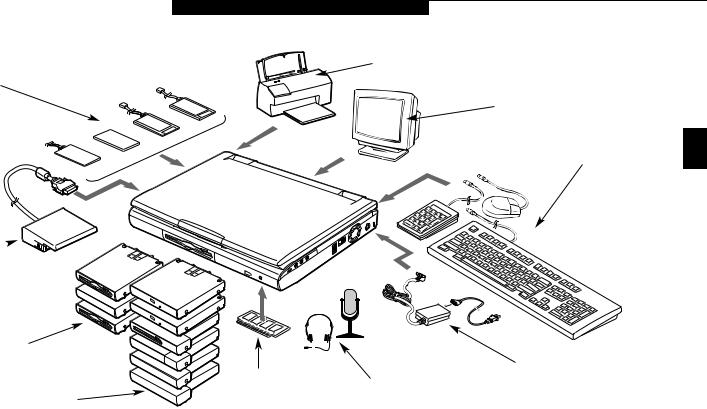
L i f e B o o k E S e r i e s f r o m F u j i t s u
L i f e B o o k E S e r i e s f r o m F u j i t s u
Printer
PCMCIA Card
External Monitor
External Keyboard, Mouse, or Numeric Keypad
FDD Adapter 
Bay 1 Devices
|
Power Adapter |
|
|
RAM |
|
|
Headphone and Mic |
|
Bay 2 Devices |
Figure P-1 LifeBook E Series with Both Fujitsu |
|
and Third Party Options |
||
|
Preface
vii

S e c t i o n O n e
Setting Up Your LifeBook E Series
Unpacking . . . . . . . . . . . . . . . . . . . 2
Overview of LifeBook E Series Features . . . . 4
Component Identification . . . . . . . . . . . 6
Top and Front Components . . . . . . . . . . 7
Left-side Panel Components . . . . . . . . . . 8
Right-side Panel Components . . . . . . . . . 9
Rear Panel Components . . . . . . . . . . . 10
Bottom Components . . . . . . . . . . . . . 11
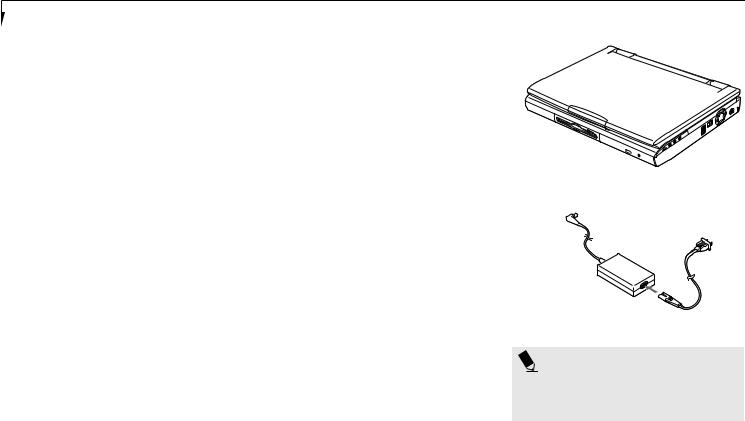
S e c t i o n O n e
SECTION ONE
SETTING UP YOUR LIFEBOOK E SERIES FROM FUJITSU
This section describes how to set up your LifeBook E Series from Fujitsu. We strongly recommend that you read it before using your notebook – even if you are already familiar with notebook computers.
UNPACKING
When you receive your notebook, unpack it carefully, and compare the parts you have received with the items listed below and with your packing label.
For a standard configuration you should have: (Your configuration may be different.)
■LifeBook E Series from Fujitsu.
(Figure 1-1.)
■AC adapter with AC power cord (located in the accessories box). (Figure 1-2.)
■Modular Lithium ion battery. (Already installed in Multi-function Bay 1 of your notebook.)
■Modular 24x maximum CD-ROM drive. (Already installed in Multi-function Bay 2 of your notebook.)
■Battery adapter for Multi-function Bay 2 (located in the accessories box.) (Figure 1-3.)
■Modular 3.5" floppy disk drive (located in the accessories box). (Figure 1-4.)
■Weight Saver for Multi-function Bay 2 (located in the accessories box.)(Figure 1-5.)
■RJ-11 cable (located in the accessories box).
■Getting Started Guide and User’s Guide.
■Microsoft Windows 95, Windows 98 or Windows NT 4.0 Manual.
■Registration card and customer information pack.
■Recovery CD-ROM
(located in the accessories box).
If you have purchased a LifeBook E370, you will also have:
■Modular Zip drive (located in the accessories box). (Figure 1-6.)
Figure 1-1 LifeBook E Series Notebook
Figure 1-2 AC Adapter Unit
P O I N T
You may have different options than those listed if you have a built-to-order LifeBook E Series.
2
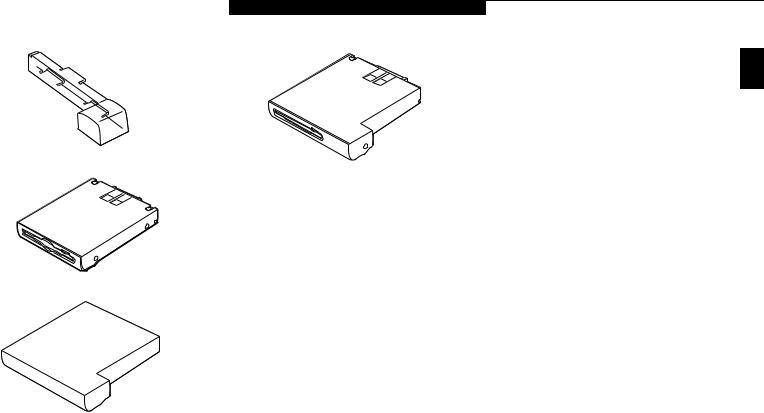
Figure 1-3 Battery Adapter for Multi-function Bay 2
Figure 1-4 Floppy Disk Drive
L i f e B o o k E S e r i e s f r o m F u j i t s u
S e t t i n g U p Y o u r L i f e B o o k E S e r i e s
Figure 1-6 Modular Zip Drive (E370 only)
Your LifeBook may have other optional devices depending on your built-to-order specifications. Please take a moment now to locate your packing slip and circle or enter the options that apply to your LifeBook specifications in the space to the right.
Once you have checked and confirmed that your notebook system is complete, read through the component identification section and learn about the features of your LifeBook.
Date Purchased: ________________________
Model Number: ________________________ |
||||||||
CPU: @ 300Mhz Celeron |
@ 300Mhz PII |
|||||||
|
@ 333Mhz PII |
@ 366Mhz PII |
||||||
LCD: @ XGA (1024x768) |
@ SVGA (800x600) |
|||||||
SDRAM: |
@ 32MB |
@ 48MB |
@ 64MB @ 96MB |
|||||
HDD: @ |
@ 128MB |
|
@ 160MB |
@ |
192MB |
|||
3.2GB |
@ |
4.3GB |
@ |
6.4GB |
||||
Communications Port: @ V.90 Modem |
||||||||
@ Fast Ethernet Module |
@ None |
|||||||
Multi-function Bay Devices: |
|
|
||||||
@ |
Floppy Disk Drive |
|
|
FPCFDD05 |
||||
@ |
SuperDisk™ 120 |
|
|
|
FPCLS02 |
|||
@ |
Iomega Zip 100 Drive |
|
FPCZIP03 |
|||||
@ |
CD-ROM Drive |
|
|
FPCCD09 |
||||
@ |
DVD Drive |
|
|
|
|
|
FPCDVD04 |
|
@ |
Lithium ion Battery |
|
|
FPCBP14 |
||||
@ |
Second 6.4GB Hard Drive |
FPCHDD23 |
||||||
@ |
Weight Saver |
|
|
|
|
FPCBB01 |
||
@ |
Floppy Disk Drive |
|
|
FPCFDA03 |
||||
|
Adapter for external FDD connection |
|||||||
Integrated Pointing Devices: |
|
|
||||||
@ |
ErgoTrac™ @ |
Touchpad |
|
|
||||
One
Figure 1-5 Weight Saver (for Multi-function Bay 2 only) |
3 |
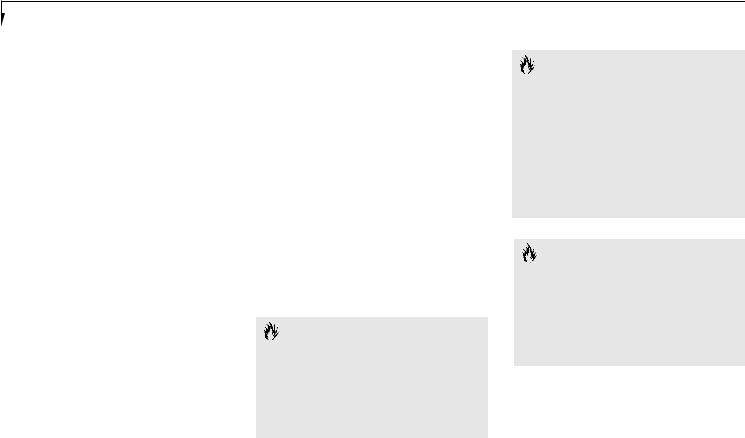
S e c t i o n O n e
OVERVIEW OF LIFEBOOK E SERIES FEATURES AND OPTIONS
The LifeBook E Series is a compact, yet powerful notebook computer available with standard features including: (See Appendix A, pages 182-186, and your packing label for detailed information on individual models and Built-to-order options.)
■300MHz, 333HMz or 366MHz Intel Pentium II or 300MHz Intel Celeron processor.
■32MB SDRAM on-board (E342) expandable to 160MB via expansion slot or 64MB SDRAM on-board (E351, E360, E370), expandable to 192MB via expansion slot.
■256K on-die L2 cache (E351, E360, E3702) or 128K on-die cache (E342).
■12.1" or 13.3" active-matrix (TFT) color display with 800 x 600 or 1024 x 768 resolution.
■2MB embedded SDRAM.
■DMI 2.0 compliant.
■Built-in 3.2GB, 4.3GB or 6.4GB hard drive.
■Multi-function Bays which support the following optional features:
■Lithium ion battery
(one included with all models).
■3.5" floppy disk drive (Bay 1 only).
4
■24x max CD-ROM drive (Bay 2 only).
■Optional SuperDisk™ 120 (Bay 1 only).
■Optional 2.0-speed max DVD-ROM drive (Bay 2 only).
■Optional Second hard drive (Bay 2 only).
■Optional Iomega Zip 100 drive (Bay 2 only) (standard with E370).
■Optional Second Lithium ion battery (Bay 1 and Bay 2 with adapter).
■Optional Floppy Disk Drive Adapter for external FDD connection.
■Weight Saver (Bay 2 only).
Depending on your specific model number or your Built-to-order options you may have one of the following:
■Internal V.90 56K fax/data/voice modem with built-in telephony support.
C A U T I O N
The internal modem is designed to the ITU-T V.90 standard. Its maximum speed of 53000bps is the highest allowed by the FCC, and its actual connection rate depends on the line conditions. The maximum speed is 33600bps at upload.
C A U T I O N
The internal modem is not intended for use with Digital PBX systems. Do not connect the internal modem to a digital PBX as it may cause serious damage to the internal modem or your entire notebook. Consult your PBX manufacturer’s documentation for details. Some hotels have Digital PBX systems. Be sure to find out BEFORE you connect your modem.
C A U T I O N
The internal modems on all Fujitsu notebooks from Fujitsu PC Corporation are not qualified for use with telephone systems outside the United States and Canada and may not operate in other countries.
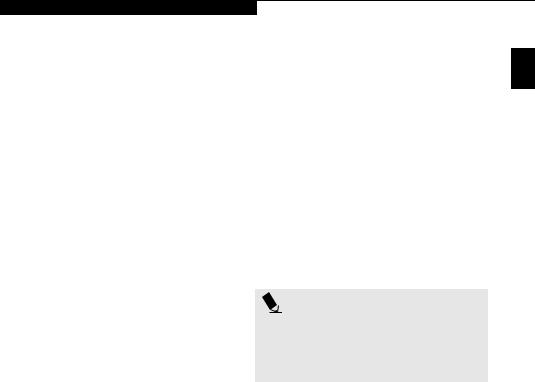
■Internal Fast Ethernet (10/100 Base-T/Tx) network interface card with RJ-45 connector. (Custom configured systems only.)
■No Modem or LAN. (Custom configured systems only.)
■Full audio and video features:
■16-bit SoundBlaster-compatible sound chip.
■3D-Stereo for multiple speaker effect.
■Zoomed Video support for full motion video acceleration. (With Windows 95 and Windows 98 only.)
■Built-in stereo speakers.
■Built-in mono microphone.
■Stereo line in jack.
■Stereo headphone jack.
■Microphone jack.
■Two Type II/one Type III PC Card slot.
■Fast IrDA (4Mbps) compatible infrared port for wireless data transfer. (Windows 95 and Windows 98 only.)
■Integrated ErgoTrac™ or Touchpad pointing device for customized comfort and cursor control. (Custom configured systems only.)
L i f e B o o k E S e r i e s f r o m F u j i t s u
S e t t i n g U p Y o u r L i f e B o o k E S e r i e s
■External monitor support with simultaneous display capabilities.
■Full-size keyboard with three dedicated Windows keys.
■Hot swap PS/2 port for an external keyboard or external mouse.
■USB device support. (Windows 95 and Windows 98 only.)
■Bridge battery for warm-swapping of batteries.
■Standard pre-installed software:
■Microsoft Windows 95, Windows 98 or Windows NT 4.0 operating system.
■LapLink for file transfer via modem, cable or infrared port. (Windows 95 and Windows 98 only.)
■PMSet 98 (Windows 98) or PowerPanel (Windows NT 4.0 and Windows 95) for system power management.
■Agate Tioman HotSwap for hot-swapping functionality in Multi-function bays (Windows 95 and Windows 98 only).
■NoteDock for hot-docking/undocking support and hot-swapping functionality in the Multi-function bays (with Windows NT 4.0 only).
■Card Executive for PCMCIA card support (Windows NT 4.0 only).
■PC-Doctor for system diagnostics.
■McAfee VirusScan for virus protection.
■ESS AudioRack for 3D-Stereo, audio CD and other audio controls (Windows 95 and Windows 98 only).
■Standard user-install software:
■AT&T WorldNet Service (Windows 95 and Windows 98 only).
■AOL (Windows 95 and Windows 98 only).
■Netscape Communicator.
■Internet Explorer (Windows 95 and Windows NT 4.0 only). (Note: Explorer comes intergrated in Windows 98).
P O I N T
McAfee VirusScan, PC-Doctor and Netscape Communicator are available on all three operating systems (Windows 95, Windows 98 and Windows NT 4.0).
One
5
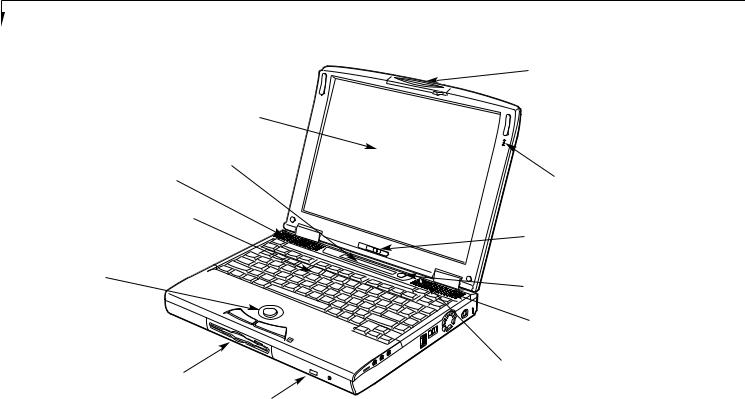
S e c t i o n O n e
COMPONENT IDENTIFICATION
For detailed specifications on each model refer to Appendix A on pages 182–186.
Display Panel
Status Indicator Panel
Stereo Speaker
Keyboard
ErgoTracTM pointing device
Multi-function Bay 1
Multi-function Bay 2
Display Panel Latch
Built-in Microphone
Brightness Control
Suspend/Resume Button
Stereo Speaker
Closed Cover Switch
Figure 1-7 LifeBook E Series with Display Open
6

TOP AND FRONT COMPONENTS
Display Panel Latch
This latch locks and releases the display panel. When the display panel is released it pops up slightly to make it easier to open. (Figure 1-7.)
Display Panel
This is a color LCD panel with back lighting for the display of text and graphics. (Figure 1-7.)
Brightness Control
The brightness control adjusts the overall intensity of the display panel back lighting.
(Figure 1-7.)
Built-in Microphone
The built-in microphone allows mono audio input to your notebook. (Figure 1-7.)
Status Indicator Panel
An LCD display of the status of the power state and source, Suspend mode, battery charge (battery in either Multi-function Bay), floppy disk drive activity, hard drive or zip drive activity, CD-ROM drive activity, PC Card activity, CapsLock, NumLk and Scr Lk. (Figure 1-7.)
L i f e B o o k E S e r i e s f r o m F u j i t s u
S e t t i n g U p Y o u r L i f e B o o k E S e r i e s
Stereo Speakers
The built-in dual speakers output stereo sound from the notebook. (Figure 1-7)
Suspend/Resume Button
The Suspend/Resume button allows you to suspend notebook activity without turning off the notebook power, and to return it to an active state. This feature saves power, and is particularly useful when the notebook is running only on battery power. (See pages 48-53 and 107-112 for more information on power management.) (Figure 1-7.)
Closed Cover Switch
The closed cover switch turns off the LCD back lighting when the display panel is closed, thus saving power. This switch also behaves as a Suspend/Resume button, when the closed cover switch is set to Suspend/Resume in the BIOS Setup Utility. (see pages 95-102 for more information on the BIOS Setup Utility)
(Figure 1-7.)
C A U T I O N
Be sure you know which settings are active for your Suspend/Resume button before you use it. Misuse can result in data loss. (See the Power Savings Menu of the BIOS setup utility, pages 107-112, for more information.)
Keyboard
A full-size keyboard with dedicated Windows keys for input into the notebook.
(Figure 1-7.)
Pointing Device
The pointing device is a mouse-like cursor control system with two click buttons.
(Figure 1-7.)
One
7
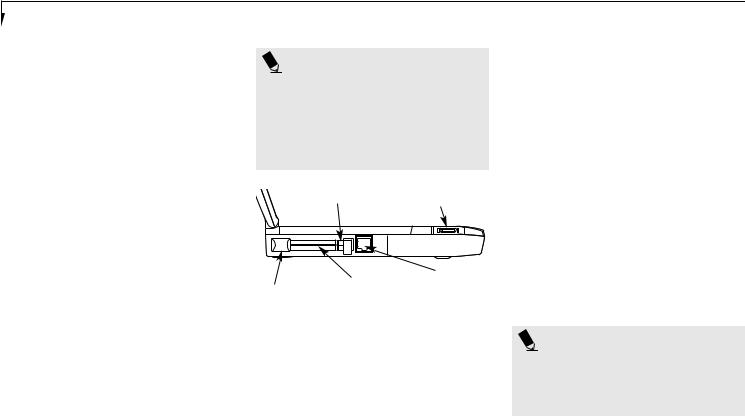
S e c t i o n O n e
Multi-function Bay One
This bay accommodates the following optional and standard devices:
■Lithium ion battery.
■Optional SuperDisk 120
■3.5" floppy disk drive.
Multi-function Bay Two
This bay accommodates the following optional and standard devices:
■24x maximum CD-ROM drive.
■Optional 1.5x maximum DVD-ROM drive.
■Lithium ion battery mounted in the Battery adapter for Multi-function Bay 2 (a second battery can be purchased separately for a dual battery configuration).
■Optional 6.4 GB Second hard drive.
■Optional Iomega Zip 100 Drive (standard with E370).
■Weight Saver.
P O I N T
The Weight Saver option for Multi-func- tion Bay 2 is meant to fill the bay when no other device is installed. It is not recommended that you use your LifeBook with no device in either of the Multifunction Bays.
PC Card Eject Buttons |
External FDD |
|
connector |
||
|
Communications port
PC Card Slots
PC Card Lock
Figure 1-8 LifeBook E Series Left-side Panel
LEFT-SIDE PANEL COMPONENTS
PC Card Slot
The PC Card Slot allows you to install two Type I or Type II PC Cards or one Type III PC Card.
(See pages 135-137 for more information on PC Cards.) The button to the left of the card slot
locks the card(s) in place, and the buttons to the right of the slot eject the card(s) from the slot. (Figure 1-8.)
Communications Port
The communications port may be configured with either an RJ-11 telephone jack for an internal 56K modem or an RJ-45 jack for an internal Fast Ethernet (10/100 Base-T/Tx) port. Check your packing sheet to see which option (if any) you have on your LifeBook.
(Figure 1-8.)
External Floppy Disk Drive Port
A port for attaching an optional external floppy disk drive with adapter. This allows you to connect an optional floppy disk drive when the Multi-function bays are being used for other purposes. (Figure 1-8.)
P O I N T
Your LifeBook may be configured with no device in the Communications port if you specified as such in your built-to- order options.
8
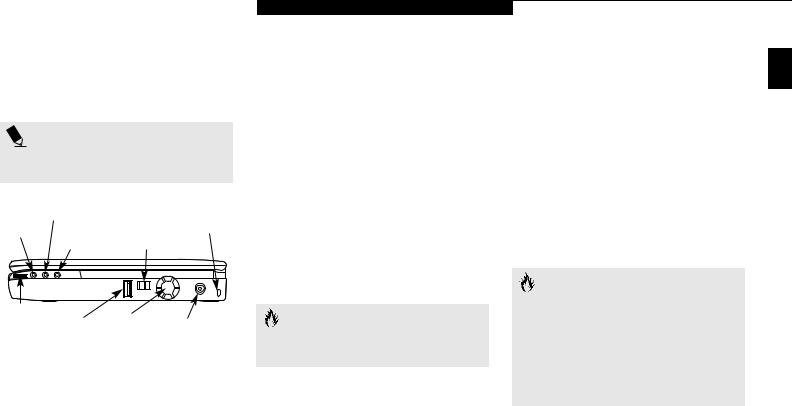
RIGHT-SIDE PANEL COMPONENTS
Theft Prevention Lock Slot
This is a slot that allows you to attach
a physical lock down device. (Figure 1-9.)
P O I N T
Windows NT 4.0 does not support USB devices at this time.
Stereo Line |
|
|
In Jack |
|
Theft Prevention |
Headphone Jack |
Microphone |
Lock Slot |
|
||
|
Jack |
Power Switch |
Volume |
USB |
Fan |
Control |
Port |
DC Power Jack |
Figure 1-9 LifeBook E Series Right-side Panel
L i f e B o o k E S e r i e s f r o m F u j i t s u
S e t t i n g U p Y o u r L i f e B o o k E S e r i e s
DC Power Jack Stereo Line In Jack
The DC power jack allows you to plug in the AC adapter or the optional auto/airline adapter.
(Figure 1-9.)
Power Switch
The stereo line in jack allows you to connect an external audio source to your notebook, like an audio cassette player. This jack will not support an external microphone. (Figure 1-9.)
This switch is the main power switch for your notebook. (Figure 1-9.)
USB Port
This port allows you to connect Universal Serial Bus devices, such as external game pads, pointing devices, keyboards and speakers.
(Figure 1-9.)
Microphone Jack
The microphone jack allows you to connect an external mono microphone. (Figure 1-9.)
C A U T I O N
FAN: Do not block the circulation of air flow.
Headphone Jack
You can connect headphones or powered external speakers to the headphone jack.
(Figure 1-9.)
Volume Control
The volume control is a knob which provides manual control of the sound level of all audio output from your notebook. (Figure 1-9.)
C A U T I O N
There are also software volume controls. The knob setting and the software settings will interact. Software volume off will override the knob setting and the software volume setting will control the maximum knob setting. (See Volume
Control on page 37 for more information.)
One
9
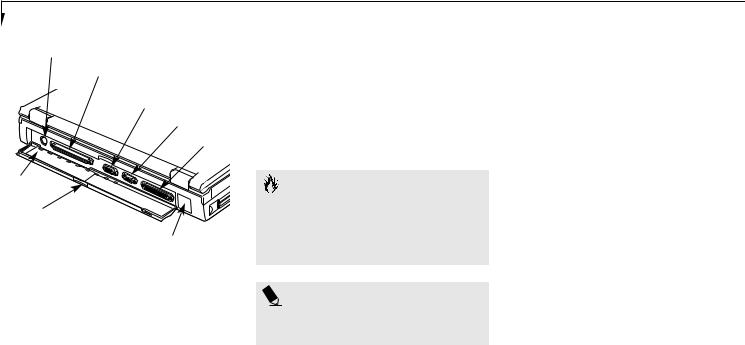
S e c t i o n O n e
PS/2 Port
Docking Port
External
Monitor Port
Serial Port
Parallel Port
Slide Panel
Connector Cover
Infrared Port
Figure 1-10 LifeBook E Series Rear Panel
REAR PANEL COMPONENTS
PS/2 Port
The port allows you to connect an external PS/2 keyboard, mouse, or numeric keypad.
(Figure 1-10.)
Docking Port
This port is for connection to an optional port replicator or docking station. The connector cover must be closed and the sliding panel fully opened to reveal the docking port and the PS/2 port when connecting a port replicator or a docking station. (Figure 1-10.)
C A U T I O N
The cover – which closes over the ports on the rear of the notebook – can be damaged if it is left open when the notebook is moved around.
P O I N T
Windows NT 4.0 does not support infrared communications.
Serial Port
The serial port allows you to connect serial RS-232C devices, such as serial printers or serial scanners. (This is also sometimes referred to as a COM port.) (Figure 1-10.)
Parallel Port
The parallel port allows you to connect parallel devices, such as a parallel printer to your notebook. (This is also sometimes referred to as a LPT port.) (Figure 1-10.)
External Monitor Port
This port allows you to connect an external VGA or SVGA monitor. (Figure 1-10.)
Infrared Port
The fast IrDA 1.1 (4Mbps) compatible port allows you to communicate with another IrDA compatible infrared device without a cable.
(See page 47 for more information.) (Figure 1-10.)
10
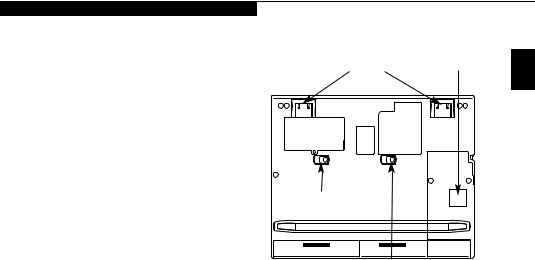
BOTTOM COMPONENTS
Tilt Adjustment Feet
These are a pair of feet which flip down and hold the back of the notebook approximately 6° higher than the front when resting on a flat surface. They are designed to make using your notebook keyboard more comfortable.
(Figure 1-11.)
Main Unit and Configuration Label
This label shows the model number and other information about your notebook. In addition the configuration portion of the label has the serial number and manufacturer information that you will need to give your support representative so that he or she can help you. It identifies the exact version of various components of your notebook. (Figure 1-11.)
Memory Upgrade Compartment
This compartment houses the memory upgrade module which allows you to expand the system memory capacity of your notebook. (See pages 141-144 for more information on installing added memory capacity.) (Figure 1-11.)
L i f e B o o k E S e r i e s f r o m F u j i t s u
S e t t i n g U p Y o u r L i f e B o o k E S e r i e s
Multi-function Bay 1 Release Button
This is the release to allow removal and installation of devices in Multi-function Bay 1.
(Figure 1-11.)
Tilt |
HDD |
Adjustment |
Compartment |
Feet |
|
Multi-function Bay 1
This compartment is accessed from the front of your notebook. (See Figure 1-7 on page 6.)
Multi-function Bay 2 Release Button
This is the release to allow removal and installation of devices in Multi-function Bay 2.
(Figure 1-11.)
Multi-function Bay 2
This compartment is accessed from the front of your notebook. (See Figure 1-7 on page 6.)
Hard Drive Compartment
Memory |
Main Unit |
Upgrade |
Label |
Compartment |
|
Multi-function Bay 2
Release Button
Multi-function Bay 1
Release Button
Figure 1-11 LifeBook E Series Bottom
This compartment houses the primary hard drive. (See Figure 1-11.)
One
11

S e c t i o n T w o
Starting Your LifeBook E Series from Fujitsu
Power Sources . . . . . . . . . . . . . . . . 14
Display Panel . . . . . . . . . . . . . . . . . 15
Adjusting the Keyboard Angle . . . . . . . . 15
Starting Your Notebook
for the First Time . . . . . . . . . . . . . . . 16 Registering Your LifeBook . . . . . . . . . . 22
Learning About Your Operating System
and Application Software . . . . . . . . . . . 24
Power Off . . . . . . . . . . . . . . . . . . 24
Restarting Your Notebook . . . . . . . . . . 25

S e c t i o n T w o
SECTION TWO
STARTING YOUR LIFEBOOK E SERIES FROM FUJITSU
This section describes the processes of starting your LifeBook for the first time, initial software setup and registration.
POWER SOURCES
Your notebook has four possible power sources: the primary Lithium ion battery; an optional dual Lithium ion battery configuration; the AC adapter; or an optional auto/airline adapter.
Connecting the Power Adapters
The AC adapter or an optional auto/airline adapter provides power for operating your notebook and charging the batteries.
(Figure 2-1.)
To Connect the AC Adapter
1.Plug the DC Output cable of the AC adapter into the DC Power jack on the right-side panel of your notebook.
2.Plug the AC adapter into an AC electrical outlet.
Figure 2-1 Connecting the AC Adapter
To Connect the Optional Auto/airline Adapter
1.Plug the DC Output cable into the DC Power jack on the right-side panel of your notebook.
2.Plug the auto/airline adapter plug into the cigarette lighter of a car or other vehicle with the ignition key in the On or the Accessories position or into the DC Power jack on an airplane seat.
To Switch From AC Adapter Power
To Battery Power
1.Be sure that you have at least one charged battery installed.
2.Remove the AC or auto/airline adapter.
C A U T I O N
The primary Lithium ion battery is not charged when you purchase your notebook. Initially you will need to connect the AC adapter or the auto/airline adapter to use it. If you purchase a second Lithium ion battery it will not be charged when you get it. You will need to charge it prior to use. It can take up to three (3) hours to charge a single battery if your notebook
is turned off or is in Suspend mode. If your notebook is in use it can take up to nine (9) hours or more to charge a single battery.
14

DISPLAY PANEL
Opening the Display Panel
Lifting the latch releases the top of the display panel from the front of the notebook body. When the display panel is released it pops up slightly to make it easier to open. Lift the display panel backward until the screen is at a comfortable viewing angle. (Figure 2-2.)
Adjusting the Display Panel
Before you turn on your notebook, you may want to adjust the brightness level of the screen. Start with the brightness control slider (located directly under the display screen) in the middle position. (Figure 2-3.)
Figure 2-2 Opening the Display Panel
L i f e B o o k E S e r i e s f r o m F u j i t s u
S t a r t i n g Y o u r L i f e B o o k E S e r i e s
Figure 2-3 Adjusting the Display
You may need to adjust the brightness levels after you start your notebook and periodically for different operating environments.
P O I N T
The higher the brightness level, the more power the notebook will consume and the faster your batteries will discharge. For maximum battery life, make sure that the brightness is set as low as possible.
ADJUSTING THE KEYBOARD ANGLE
On the bottom of your notebook, near the back, are a pair of feet which flip down and hold the back of the notebook about 6° higher than the front when resting on a flat surface. They are designed to make it more comfortable to use the keyboard with your notebook. The feet must be folded flat against the bottom
of the notebook when opening or using the CD-ROM drive or it will not open or operate properly.
C A U T I O N
Do not operate your CD-ROM drive or attempt to open the tray unless your
notebook is sitting on a flat surface and the adjustment feet are folded against the bottom of the notebook. Using a CD-ROM drive when it is not level may damage the drive or prevent proper operation.
Two
15
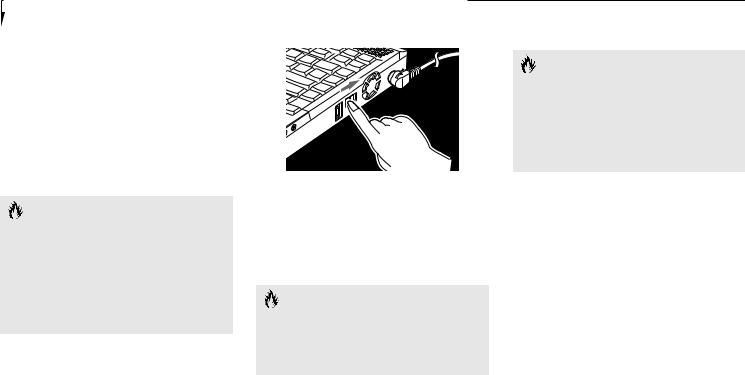
S e c t i o n T w o
STARTING YOUR NOTEBOOK FOR THE FIRST TIME
Power On
The power switch is located on the right side of your notebook. This switch is used to turn On the computer from its Off state. Once you have connected your AC adapter or have charged the internal Lithium ion Battery, you can power On your notebook.
C A U T I O N
The main Lithium ion battery is not charged when you purchase your notebook. Initially you will need to connect the AC adapter to use it. If you purchase an optional second Lithium ion battery, it will not be charged when you get it, you will need to charge it prior to use.
Facing the keyboard and display panel, move the power switch towards the rear of your notebook. This is the On position. (See Figure 2-4.) When you are done working you can leave your note-
Figure 2-4 Power On
book in Suspend mode, (see page 49), or you can turn it off. The power switch moved toward the front of your notebook is in the Off position.
(See the section Power Off, pages 24-25, for the recommended shutoff procedures.)
C A U T I O N
Do not carry your notebook around with the power on or subject it to shocks or vibration, as you risk damaging
your notebook.
C A U T I O N
When you turn on your notebook be sure you have a power source. This means that at least one battery is installed and charged, or that the AC adapter or the auto/airline adapter is connected and has power.
When the power switch is turned on, your notebook carries out a Power On Self Test (POST) to check the internal parts and configuration. If a fault is found a beep will sound and/or an error message will be displayed.
(See Troubleshooting on pages 170-172) Depending on the nature of the problem you may be able to continue by starting the operating system or by entering the BIOS setup utility and revising the settings.
After satisfactory completion of the Power On Self Test (POST) your notebook will load your operating system. (See Boot Menu on pages 115116 to see which kind of disk will be the source.)
16

C A U T I O N
Never turn off your notebook during Power On Self Test (POST) or it will cause an error message to be displayed when you turn your notebook on the next time. (See the Troubleshooting information on pages 170-172.)
Booting the System with Windows 95
We strongly recommend that you not attach any other external devices and do not put any CD or floppy disk in your drives until you have gone through the initial power on sequence.
When you turn on your notebook it will display a Fujitsu logo on the screen. If you do nothing the system will read the hard drive for the operating system software, flash the notebook configuration information on the screen, and load the Windows 95 Setup Wizard. You will then be stepped through the condition of use process. You must complete this initial process before you will be able to use your notebook. (If you
L i f e B o o k E S e r i e s f r o m F u j i t s u
S t a r t i n g Y o u r L i f e B o o k E S e r i e s
wish to access the BIOS setup utility before you go through the Condition of Use Process you must press the F2 key while the Fujitsu logo is still visible. If you press the Esc key while the Fujitsu logo is still present you will get a dialog box which will allow you to select which drive is to be used for finding the operating system.) If you turn off the power without using the on screen Cancel button you will get an error message when you start your notebook again.
Condition of Use Process
The first time you start your notebook you must confirm your acceptance of the copyright limitations for your pre-installed software. After you complete the Condition of Use Process these screens will not appear again. There are 6 screens to read carefully and respond to.
You cannot use your notebook until this Condition of Use Process is completed. The bottom of each screen has a <Back button, a Next> Button and a Cancel button which are activated by the integrated ErgoTrac or TouchPad cursor control and button click. The
<Back button will return you to the previous screen. The Next> button activates any choices or information you have entered and takes you on to the next screen. The Cancel button allows you to stop the setup process.
If you stop the process your notebook will start up at the beginning of the Windows 95 Setup Wizard.
The screens you will be required to respond to are described with the required action.
User Information
Fill in your name and your company name as you want the software licensed. To step from the name blank to the company blank press the Tab key. When the information has been entered click on the Next> button. You will not be allowed to continue until you make an entry.
License Agreement
Read the agreement carefully. You can scroll through the text using the integrated ErgoTrac or TouchPad pointing device to activate the
Two
17
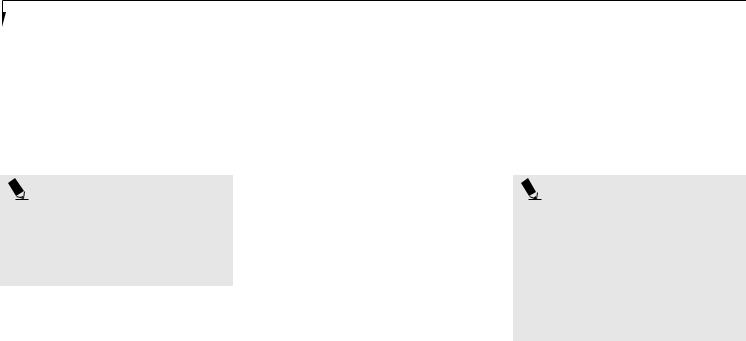
S e c t i o n T w o
scroll bar or use the up arrow ’ and down arrow ‘ keys to move up and down the text one line at a time, or use the Page Up and Page Down keys to move the text one screen at a time. When you finish reading you must
point and click to accept or reject the terms of the agreement and then click on the Next> button.
P O I N T
If you reject the terms of the license agreement you will be asked to review the license agreement for information on returning Windows 95 or to shut down your notebook.
Certificate of Authenticity
Look in the box that your notebook came in and you will find a Windows 95 Certificate of Authenticity shrink wrapped with the Windows 95 Users manual. On the certificate you will find a bar-code with a number above it. This is your product code and the number you should
enter on the Certificate of Authenticity screen. When you have entered the number exactly as shown then click on the Next> button.
Start Wizard
The Start Wizard screen will appear if you have entered a valid product code. When you click on the Finish button the display will flash various screens as the system identifies what hardware is installed.
Time Zone
When your notebook has completely identified all of the installed hardware it will display a dialog box for entering which time zone you wish to set the clock to.
Printer Setup
When the messaging setup is complete a dialog box will appear for selecting which printer is to be attached to your notebook. You do not have to select a printer at this time. If you do not wish to select a printer, click on the Cancel button. If you do wish to select a printer click on the Next button and answer the questions.
Windows 95 Setup
Once you have completed the printer setup, or if you have chosen not to set up a printer at this time, you will see the Windows 95 Setup screen. This screen lets you set up Internet Explorer 4.01 with Active Desktop on your Lifebook. Follow the on-screen direction to complete installation of IE 4.01
P O I N T
If you would like to skip the installation of Internet Explorer 4.01, go to the Start Menu on the desktop, select Shutdown and Restart the computer. After returning to Windows, you can install Internet Explorer 4.01 at any time by selecting the icon Setup for Internet Explorer 4.01 in the Internet Starts Here folder on
the desktop.
18

Booting the System with Windows 98
We strongly recommend that you not attach any other external devices and do not put any CD or floppy disk in your drives until you have gone through the initial power on sequence.
When you turn on your notebook for the first time it will display a Fujitsu logo on the screen. If you do nothing the system will read the hard drive for the operating system software, flash the notebook configuration information on the screen, and then the Windows 98 Setup Wizard Screen will appear. You will then be stepped through the condition of use process. You must complete this initial process before you will be able to use your notebook. (If you wish to access the BIOS setup utility before you go through the condition of use process you must press the F2 key while the Fujitsu logo is still visible. If you press the Esc key while the Fujitsu logo is still present you will get a dialog box which will allow you to select which drive is to be used for finding the operating system.) If you turn off the power without using the on screen Cancel button you will get an error message when you start your notebook again.
L i f e B o o k E S e r i e s f r o m F u j i t s u
S t a r t i n g Y o u r L i f e B o o k E S e r i e s
Condition of Use Process
The first time you start your notebook you must confirm your acceptance of the copyright limitations for your pre-installed software. After you complete the Condition of Use process these screens will not appear again. There are
6 screens to read carefully and respond to.
You cannot use your notebook until this Condition of Use process is completed. The bottom of each screen has a <Back button, a Next> Button and a Cancel button which are activated by the integrated ErgoTrac or TouchPad cursor control and button click. The <Back button will return you to the previous screen. The Next> button activates any choices or information you have entered and takes you on to the next screen. The Cancel button allows you to stop the setup process.
If you stop the process your notebook will start up at the beginning of the Windows 98 Setup Wizard.
The screens you will be required to respond to are described with the required action.
User Information
Fill in your name and your company name as you want the software licensed. To step from the name blank to the company blank press the Tab key. When the information has been entered click on the Next> button. You will not be allowed to continue until you make an entry.
License Agreement
Read the agreement carefully. You can scroll through the text using the integrated ErgoTrac or TouchPad pointing device to activate the scroll bar or use the up arrow ’ and down arrow ‘ keys to move up and down the text one line at a time, or use the Page Up and Page Down keys to move the text one screen at a time. When you finish reading you must
point and click to accept or reject the terms of the agreement and then click on the Next> button.
Two
19

S e c t i o n T w o
P O I N T
If you reject the terms of the license agreement you will be asked to review the license agreement for information on returning Windows 98 or to shut down your notebook.
Product Key
Look in the box that your notebook came in and you will find a Windows 98 Certificate of Authenticity shrink wrapped with the Windows 98 Users manual. On the certificate you will find a bar-code with a number above it. This is your product key and the number you should enter on the Product Key screen. When you have entered the number exactly as shown then click on the Next> button.
Start Wizard
The Start Wizard screen will appear if you have entered a valid product key. When you click on the Finish button the display will flash various screens as the system identifies what hardware is installed.
Time Zone
When your notebook has completely identified all of the installed hardware it will display a dialog box for entering which time zone you wish to set the clock to.
Printer Setup
When the time zone setup is complete a dialog box will appear for selecting which printer is to be attached to your notebook. You do not have to select a printer at this time. If you do not wish to select a printer, click on the Cancel button. If you do wish to select a printer click on the Next button and answer the questions.
Welcome to Windows 98
When you boot into Windows 98 for the first time you will see a Welcome to Windows 98 dialog box with several options. Select the first option, Register Now, to register your LifeBook E Series notebook. (See page 21 in this section for details on registering your notebook in Windows 98.)
Booting the System with Windows NT 4.0
We strongly recommend that you not attach any other external devices and do not put any CD or floppy disk in your drives until you have gone through the initial power on sequence.
When you turn on your notebook for the first time it will display a Fujitsu logo on the screen. If you do nothing the system will read the hard drive for the operating system software, flash the notebook configuration information on the screen, and then the Windows NT 4.0 Setup Wizard Screen will appear. You will then be stepped through the condition of use process. You must complete this initial process before you will be able to use your notebook. (If you wish to access the BIOS setup utility before you go through the condition of use process you must press the F2 key while the Fujitsu logo is still visible. If you press the Esc key while the Fujitsu logo is still present you will get a dialog box which will allow you to select which drive is to be used for finding the operating system.) If you turn off the power without using the on screen Cancel button you will get an error message when you start your notebook again.
20
